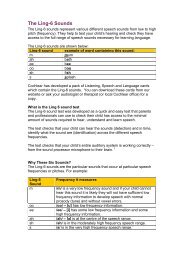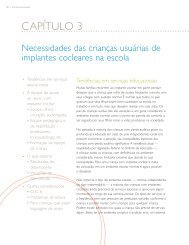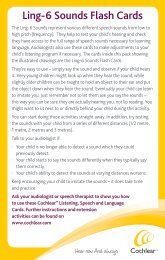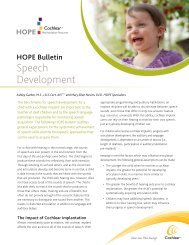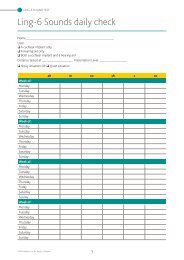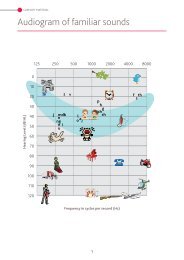Download the speech acoustics made easy sheet - Cochlear
Download the speech acoustics made easy sheet - Cochlear
Download the speech acoustics made easy sheet - Cochlear
You also want an ePaper? Increase the reach of your titles
YUMPU automatically turns print PDFs into web optimized ePapers that Google loves.
Speech Acoustics Made Easy<br />
Why do I need to know?<br />
As a parent, carer, relative or professional<br />
working with a person with a cochlear implant,<br />
you will find that a basic understanding of <strong>speech</strong><br />
sounds and <strong>the</strong>ir acoustic properties will help<br />
you to understand why your cochlear implant<br />
team professional may be recommending certain<br />
strategies and techniques and how you can help<br />
to get <strong>the</strong> best results with a cochlear implant.<br />
This is particularly important when a child is<br />
learning to listen for <strong>the</strong> first time.<br />
It is useful to remember that only 40% of English<br />
<strong>speech</strong> sounds are readable on <strong>the</strong> lips.Today’s<br />
hearing aid and cochlear implant technology<br />
enables recipients to hear all <strong>speech</strong> sounds<br />
across <strong>the</strong> frequency range. Combined with<br />
appropriate (re) habilitation support, hearing<br />
impaired children and adults are able to develop<br />
and use <strong>the</strong>ir listening abilities to communicate<br />
effectively with people around <strong>the</strong>m.<br />
For children, it is also important to remember<br />
that reading is an auditory activity:We learn to<br />
read by associating groups of <strong>speech</strong> sounds<br />
through <strong>the</strong>ir auditory properties – that is, <strong>the</strong><br />
way <strong>the</strong>y sound.<br />
How are <strong>speech</strong> sounds described?<br />
In acoustic terms, vowel sounds and consonant<br />
sounds are described by <strong>the</strong>ir average pitch<br />
(frequency, measured in Hertz – Hz) and<br />
<strong>the</strong>ir average loudness (intensity, measured in<br />
decibels – dB) at conversational <strong>speech</strong> levels.<br />
The term formant is used to refer to peaks of<br />
acoustic energy in <strong>speech</strong> sounds.<br />
What are <strong>the</strong> important acoustic<br />
aspects of spoken English?<br />
In English, vowel sounds are typically lower<br />
pitched than most consonant sounds.They are<br />
also perceived as louder and longer, so are<br />
generally easier to hear. However, most of <strong>the</strong><br />
meaning in spoken English is carried by <strong>the</strong><br />
higher frequency consonant sounds, <strong>the</strong>refore<br />
<strong>the</strong>y add far more to <strong>the</strong> overall intelligibility of<br />
<strong>speech</strong> than vowel sounds.<br />
To illustrate this point, look at <strong>the</strong> following<br />
sentence with <strong>the</strong> consonants removed, and<br />
<strong>the</strong>n with <strong>the</strong> vowels removed:<br />
“ e a a o e a “<br />
“th c t s t n th m t”<br />
The sentence (“The cat sat on <strong>the</strong> mat”) is<br />
much easier to work out with <strong>the</strong> consonants<br />
in place.<br />
What impact does this have on a<br />
person with a hearing impairment?<br />
Because consonant sounds are spoken more<br />
softly than vowel sounds, <strong>the</strong>y are often ‘drowned<br />
out’ by <strong>the</strong> vowel sounds. Any background noise<br />
serves to drown <strong>the</strong>se soft sounds even fur<strong>the</strong>r.<br />
Remember in optimal listening conditions,<br />
cochlear implant users are able to perceive very<br />
quiet <strong>speech</strong> sounds, but once <strong>the</strong>se sounds are<br />
in words and running <strong>speech</strong>, <strong>the</strong>y become<br />
harder to hear.<br />
English Vowel Sounds<br />
3000Hz<br />
2500Hz<br />
2000Hz<br />
1500Hz<br />
1000Hz<br />
500Hz<br />
250Hz<br />
125Hz<br />
= F1 = F2<br />
Who Would Know More Of Art Must Learn Again And Then Take His Ease<br />
What does this graph mean?<br />
This graph shows <strong>the</strong> average of <strong>the</strong> first two<br />
peaks of acoustic energy (formants) for each<br />
vowel in English. In order to be able to hear all of<br />
<strong>the</strong> vowels, a person only needs good aided<br />
hearing in <strong>the</strong> <strong>speech</strong> intensity range of 50 -<br />
60dBA up to 1000Hz. In order to discriminate<br />
between <strong>the</strong> vowels, that person needs to hear<br />
up to 3000Hz – and this helps us to discriminate<br />
between words that o<strong>the</strong>rwise sound <strong>the</strong> same:<br />
e.g. bad, bed, bead, bid, bird.<br />
Hear now. And always<br />
<strong>Cochlear</strong>
English Consonant Sounds<br />
Hearing Level dB<br />
-10<br />
0<br />
10<br />
20<br />
30<br />
40<br />
50<br />
60<br />
70<br />
80<br />
90<br />
100<br />
110<br />
120<br />
z v<br />
mdb<br />
n<br />
ng<br />
What does this graph mean?<br />
This graph shows <strong>the</strong> average frequency of<br />
some of <strong>the</strong> consonant sounds in British English,<br />
when spoken at conversational levels. It is worth<br />
remembering that most consonant sounds have<br />
complex peaks of acoustic energy, <strong>the</strong>refore this<br />
graph only represents <strong>the</strong> frequency at which<br />
each consonant is most audible.You can see that<br />
some sounds are low pitched and relatively loud<br />
such as <strong>the</strong> nasal sounds ‘m, n and ng’ (as in<br />
f th<br />
p s<br />
h k g t<br />
ch<br />
sh<br />
125 250 500 1000 2000 4000 8000<br />
Frequency Hz<br />
sing), whereas o<strong>the</strong>rs are high pitched and quiet,<br />
such as ‘f, s and th’ (as in thin). Compare <strong>the</strong>se<br />
with <strong>the</strong> lower pitched, louder vowel sounds.<br />
The graph also shows <strong>the</strong> average pitch and<br />
loudness of a range of environmental sounds.<br />
As most of <strong>the</strong>se sounds are louder than<br />
conversational <strong>speech</strong>, it is important to try<br />
to minimise <strong>the</strong>se background noises as much<br />
as possible.<br />
How can we all help?<br />
●<br />
●<br />
●<br />
●<br />
Use a normal conversational loudness levels<br />
Very loud <strong>speech</strong> can make vowel sounds<br />
louder drowning out <strong>the</strong> consonant sounds<br />
fur<strong>the</strong>r. Loud <strong>speech</strong> can also lead to a<br />
distorted signal which <strong>the</strong> hearing impaired<br />
person finds even more difficult to<br />
understand. Finally, talking loudly often makes<br />
lip patterns more difficult to read.<br />
To make sounds easier to hear, move<br />
closer to <strong>the</strong> microphone<br />
Position yourself close to <strong>the</strong> microphone on<br />
<strong>the</strong> hearing aid or <strong>speech</strong> processor.This is<br />
especially important with young children and<br />
can be easily achieved during comforting,<br />
play, reading books toge<strong>the</strong>r and during<br />
mealtimes when sat at <strong>the</strong> table.<br />
Remember: move closer ra<strong>the</strong>r than raising<br />
your voice.<br />
Use FM systems in schools, colleges and<br />
during meetings<br />
This has <strong>the</strong> same effect as moving closer to<br />
<strong>the</strong> microphone.<br />
Reduce background noise whenever possible<br />
Turn off <strong>the</strong> television or radio at home,<br />
use acoustic treatments* in schools and<br />
workplaces. Encourage ‘good listening’ for<br />
<strong>the</strong> whole class at school.<br />
●<br />
●<br />
●<br />
Use a sing-song voice with young children<br />
This makes <strong>speech</strong> more interesting and<br />
keeps <strong>the</strong> child’s attention for longer.<br />
Carry out daily checks of <strong>the</strong> device to<br />
ensure it is working optimally.<br />
Use monitor earphones to listen to <strong>the</strong><br />
quality of <strong>the</strong> microphone. Perform a Ling<br />
Sound test with children * . Keep <strong>the</strong><br />
processor clean and use a dry store<br />
overnight<br />
Use short, meaningful phrases<br />
Try not to use single words in isolation.<br />
Single words do not give people with<br />
hearing impairment time to “tune in” and<br />
do not help children to learn <strong>the</strong> rules of<br />
language. Contextual and grammatical cues<br />
form a large part of <strong>speech</strong> understanding,<br />
even for people who hear normally.<br />
* Your hearing specialist or member of your cochlear implant<br />
programme should be able to help you with this.<br />
<strong>Cochlear</strong> Europe Ltd., 22–24 Worple Road,Wimbledon, London SW19 4DD<br />
Tel: 020 8879 4900 Fax: 020 8946 9066<br />
Learn more about <strong>Cochlear</strong> and Nucleus ® Freedom by visiting www.cochlear.com<br />
Hear now. And always<br />
<strong>Cochlear</strong>




